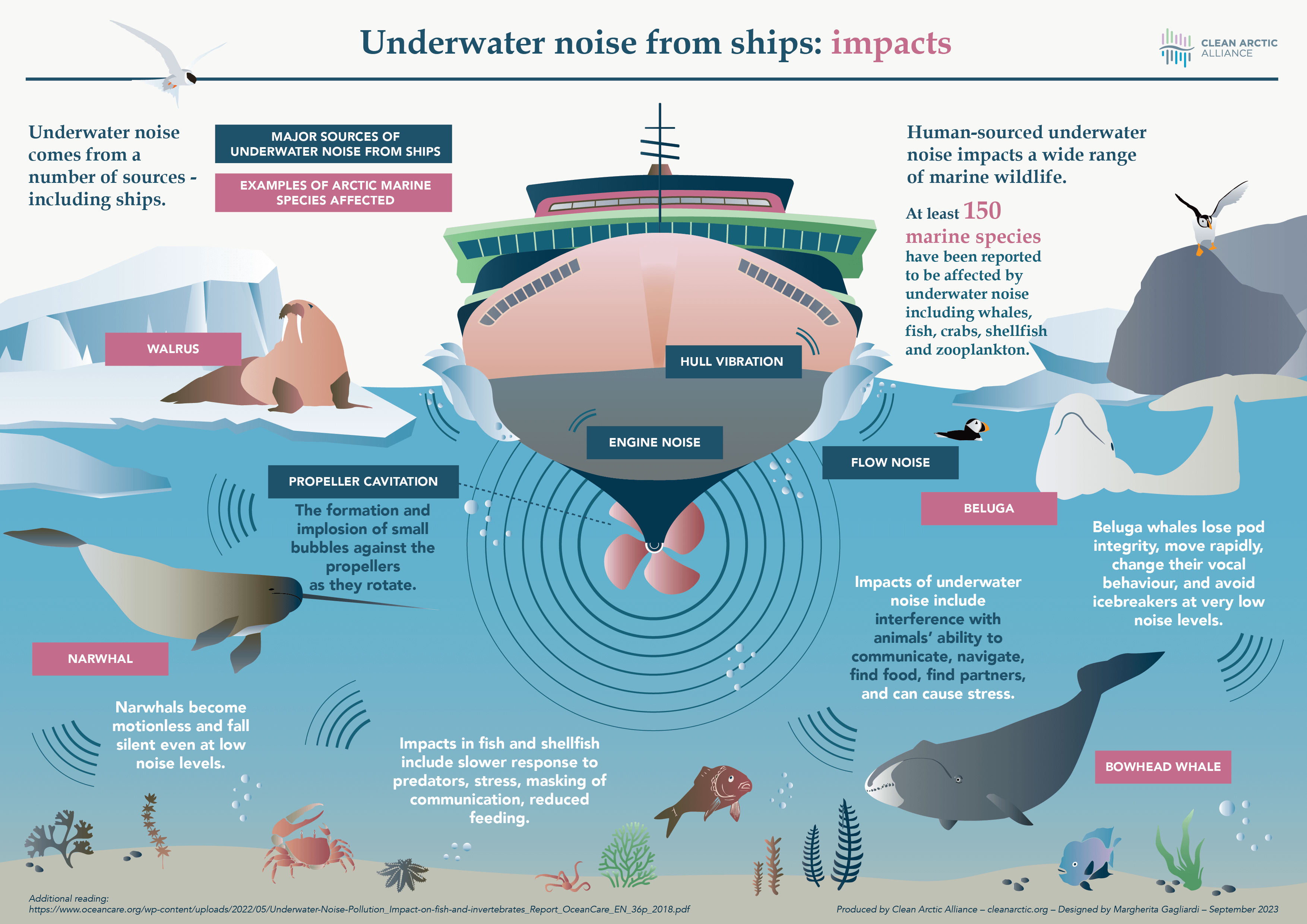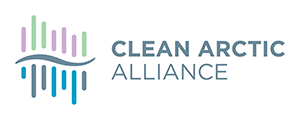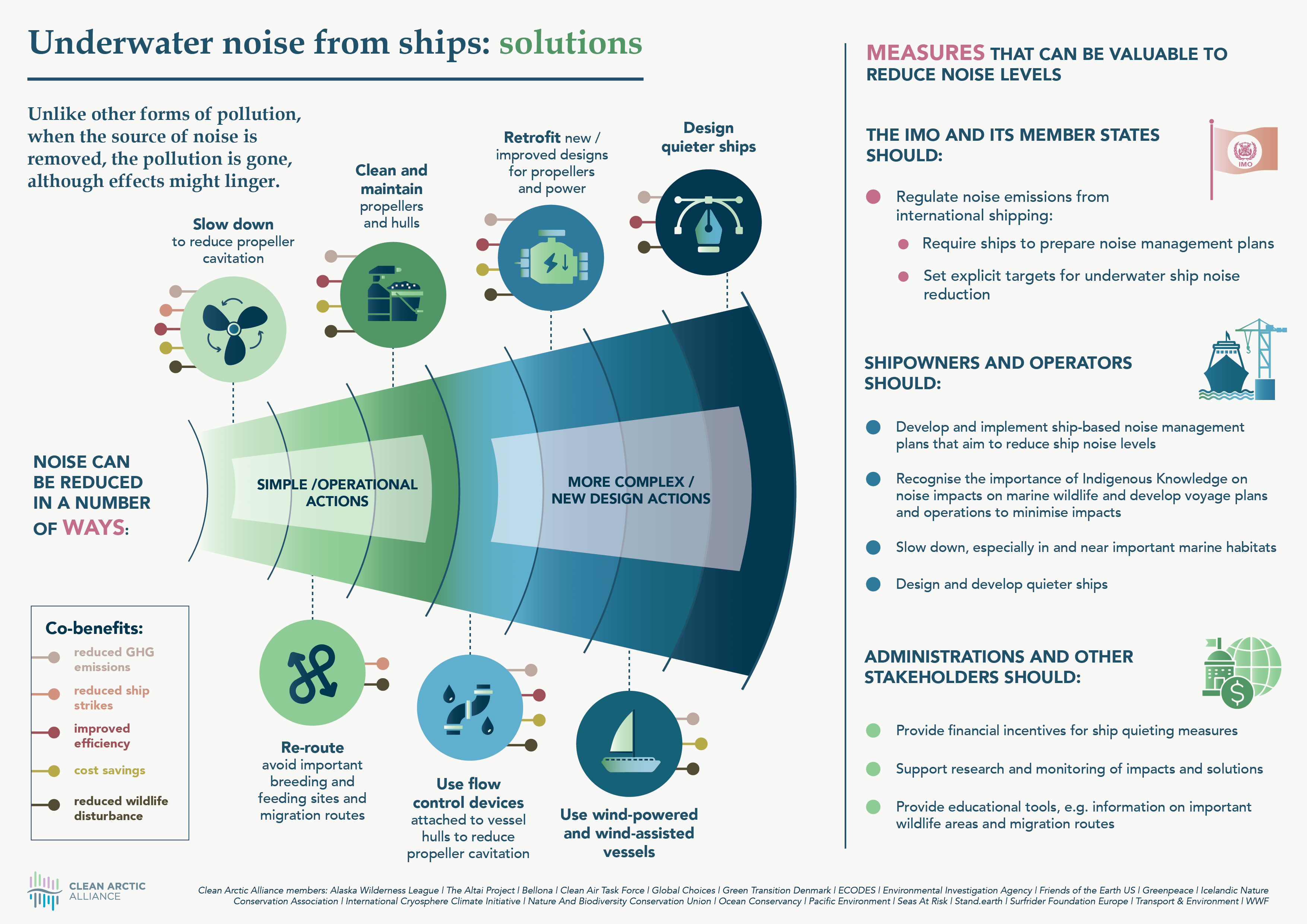
London, 22 January 2024:- As a meeting of the International Maritime Organization’s Sub-Committee on Ship Design and Construction (SDC 10) opens today in London, the Clean Arctic Alliance is calling on the maritime sector to reduce the impact of underwater noise from shipping on Arctic wildlife:
“Underwater noise levels from shipping are increasing in Arctic waters, threatening both Indigenous communities and wildlife who depend on marine resources for food – yet there is no regulation of this noise pollution. Up to now, the IMO has spent too long focusing on voluntary guidelines instead of moving to mandatory noise reduction measures”, said Dr Sian Prior, Lead Advisor to the Clean Arctic Alliance. “During this week’s meeting, the IMO has the chance to put in place an action plan that includes formulating best practices for underwater noise management planning, experience-building to reduce underwater noise, and laying the groundwork for new policy, all important steps to moving towards mandatory measures that ensure noise pollution from ships is reduced throughout our oceans”.
During SDC10, Clean Arctic Alliance specifically calls on the IMO member states to:
- Develop a recommended structure and a plan for the IMO’s Experience Building Phase (EBP). This could be accomplished by adding this task to the terms of reference for the proposed Working Group on the Review of the Guidelines.
- A new task be included in the proposed action plan directing SDC 10 to submit an information document to MEPC 82 (30 Sept – 4 Oct 2024) detailing the energy efficiency measures that provide underwater noise reduction benefits and those that offer no benefits or have a negative effect on underwater noise for consideration by MEPC in its revision of the Carbon Intensity Indicator (CII) [2].
- During SDC 10, discuss and agree upon a recommendation that identifies an appropriate process for implementing the action plan in a timely manner, and seek approval of the recommendation by MEPC 81 (18 – 22 March 2024) as a matter of urgency.
- Support the inclusion of an Implementation Framework for the Guidelines for Underwater Radiated Noise Reduction in Inuit Nunaat and the Arctic. In a paper submitted to SDC 10, The Inuit Circumpolar Council is asking for a ‘how to’ document to be developed for ships to implement the Inuit Nunaat guidelines. As the Arctic is a special case there needs to be specific focus on ways ships can reduce noise, take into account Indigenous Knowledge and community perspectives, and protect fragile ecosystems. [3]
“Significantly tackling underwater noise is a key measure in prioritising actions within the marine sector which together have the co-benefits of combating the climate crisis and reversing biodiversity loss”, said Andrew Dumbrillle, Clean Arctic Alliance advisor and report co-author of Navigating the Future: Bridging Shipping, Biodiversity, and Decarbonization, which shows how meeting biodiversity goals such as reducing underwater noise can support positive climate outcomes. “By focusing efforts in this way, the marine sector can step up to seriously addressing the urgency of our planetary crises. With 2023 recorded as the hottest year on record, ways to swiftly act in the intersection of threats has never been more pressing”.
“According to a recently published EU Copernicus report, 2023 was the warmest year on record, close to 1.5°C above pre-industrial level. July and August 2023 were the warmest two months on record and boreal summer (June-August) was also the warmest season on record”, said John Maggs, president of the Clean Shipping Coalition. “Actions which significantly address the climate crisis should be the IMO’s number one priority and a lens which the marine sector brings to all its work. Reducing underwater noise provides a prime opportunity to change the paradigm of how and which solutions are implemented in 2024. With the recent agreement to reduce greenhouse gas emission from shipping by 30% by 2030, short term actions and cross-issue mitigation measures need to be implemented, fast.”
“Introducing energy efficiency measures and slowing ships down could provide a triple win, by reducing emissions, and also reducing underwater noise and the risk of whale strikes”, according to Eelco Leemans, Clean Arctic Alliance technical advisor. “Slowing ships down will instantly reduce underwater noise and at the same time reduce risks of collision. Since propellers are the main noise source, new types of propellers designed to reduce cavitation which causes noise, should be the norm in the near future”.
“By the end of this week’s meeting, we hope that the IMO has put in place a robust structure for the experience building phase on underwater noise, along with an ambitious process for implementation of the action plan so we can immediately see more tangible steps toward reducing address underwater noise pollution from ships”, concluded Sarah Bobbe, Senior Arctic Program Manager with Ocean Conservancy. “Development of an implementation framework for addressing underwater noise reduction in Inuit Nunaat and the Arctic must also be prioritised to contribute to the safeguarding of Arctic wildlife and Indigenous communities”.
About Underwater Noise:
For many marine organisms sound is the most important means of communication. Under water, vision is restricted and without good hearing ability, elementary functions such as navigating, finding prey and partners can be hampered. This is of particular importance for marine mammals, and also for fish and even invertebrates.
The Arctic has been almost free of anthropogenic (human-sourced) sound for a long time, but with increased human activity, the Arctic Ocean is becoming more noisy every year. An important source of continuous noise is shipping, specifically from propellers and engines. Since shipping has increased substantially during recent decades, underwater noise is a growing problem, contributing to serious impact on the Arctic ecosystem.
According to a study by Transport Canada, the World Maritime University and WWF, the existing guidelines have not been effective in reducing underwater noise, namely because of their voluntary, non-regulatory nature. Research from the Arctic Council has shown that Arctic underwater noise has significantly increased in recent years. Ship traffic is also increasing in the Arctic, and given the unique special Arctic environment, underwater noise from ships has a much higher impact than in other parts of the global ocean.
The most important source of continuous underwater noise in shipping is cavitation, or production of vacuum bubbles by propellers. The noise produced by this process leads to masking, where the frequency of ship noise overlaps with sound produced and used by marine mammals.
International Policy
The International Maritime Organization adopted voluntary guidelines for underwater noise in 2014. There are no signs that these guidelines have had any effect and in June 2021 the IMO agreed to “commence further work on underwater noise from ships”.
Revised Guidelines for the reduction of underwater noise from commercial shipping (MEPC.1/Circ.906) were approved in 2023 to address the adverse impacts on marine life. A three year experience building phase in using the guidelines was agreed and a complementary action plan which includes actions to increase awareness and uptake of the guidelines. In addition, Guidelines for underwater radiated noise reduction in Inuit Nunaat and the Arctic, developed by the Inuit Circumpolar Council have also been approved.
Since worldwide regulations to mitigate continuous underwater noise by ships are currently not in place, noise mitigation measures are only applied in certain situations or for specific purposes.
The EU, in its Marine Framework Directive has set a descriptor for continuous underwater noise (D11C2): “…the spatial distribution, timeframe and levels of background noise is at such a level that it will not have adverse effects on marine ecosystems”.
For more information about Underwater Noise, visit the Clean Arctic Alliance website:
https://cleanarctic.org/campaigns/arctic-biodiversity/wildlife-underwater-noise-pollution/
ENDS
Downloads:
- SDC 10 Papers:
- SDC 10-5-7: Review of the 2014 Guidelines for the Reduction of Underwater Noise from Commercial Shipping to Address Adverse Impacts on Marine Life – Inuit Circumpolar Council
- SDC 10-5-8: Review of the 2014 Guidelines for the Reduction of Underwater Noise from Commercial Shipping to Address Adverse Impacts on Marine Life (MEPC.1/Circ.833) and Identification of Next Steps – FOEI, WWF, IFAW, Pacific Environment and CSC
- Infographic: Underwater Noise From Ships
- Watch video – Underwater Noise Webinar: Recent Innovations in Reducing URN from Ships (12 January 2022)
Contact:
Dave Walsh, Communications Advisor, [email protected], +34 691 826 764
Notes:
[1] https://www.imo.org/en/mediacentre/MeetingSummaries/Pages/Default.aspx
[2] From 1 January 2023 it will be mandatory for all ships to calculate their attained Energy Efficiency Existing Ship Index (EEXI) to measure their energy efficiency and to initiate the collection of data for the reporting of their annual operational carbon intensity indicator (CII) and CII rating.
https://www.imo.org/en/MediaCentre/PressBriefings/pages/CII-and-EEXI-entry-into-force.asp
[3] Guidelines For Underwater Radiated Noise Reduction in Inuit Nunaat and the Arctic
About the Clean Arctic Alliance
Made up of 22 not-for-profit organisations, the Clean Arctic Alliance campaigns to persuade governments to take action to protect the Arctic, its wildlife and its people.
Members include: The Altai Project, Alaska Wilderness League, Bellona, Clean Air Task Force, Ecology and Development Foundation ECODES, Environmental Investigation Agency, Friends of the Earth US, Global Choices, Green Global Future, Green Transition Denmark, Greenpeace, Iceland Nature Conservation Association, International Cryosphere Climate Initiative, Nature And Biodiversity Conservation Union, Ocean Conservancy, Pacific Environment, Seas At Risk, Surfrider Foundation Europe, Stand.Earth, Transport & Environment, WWF and Zero.
More more information visit https://www.cleanarctic.org/


